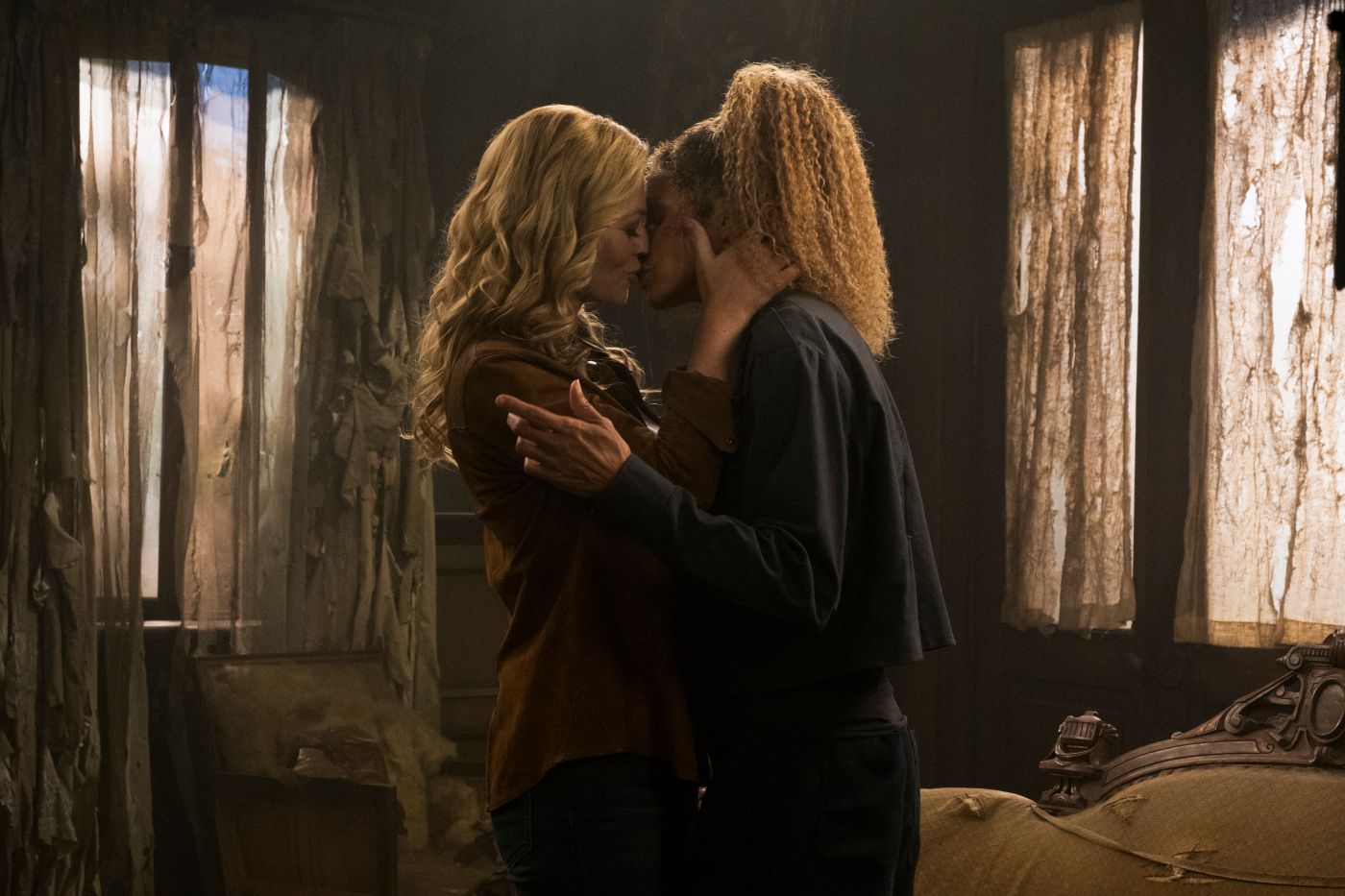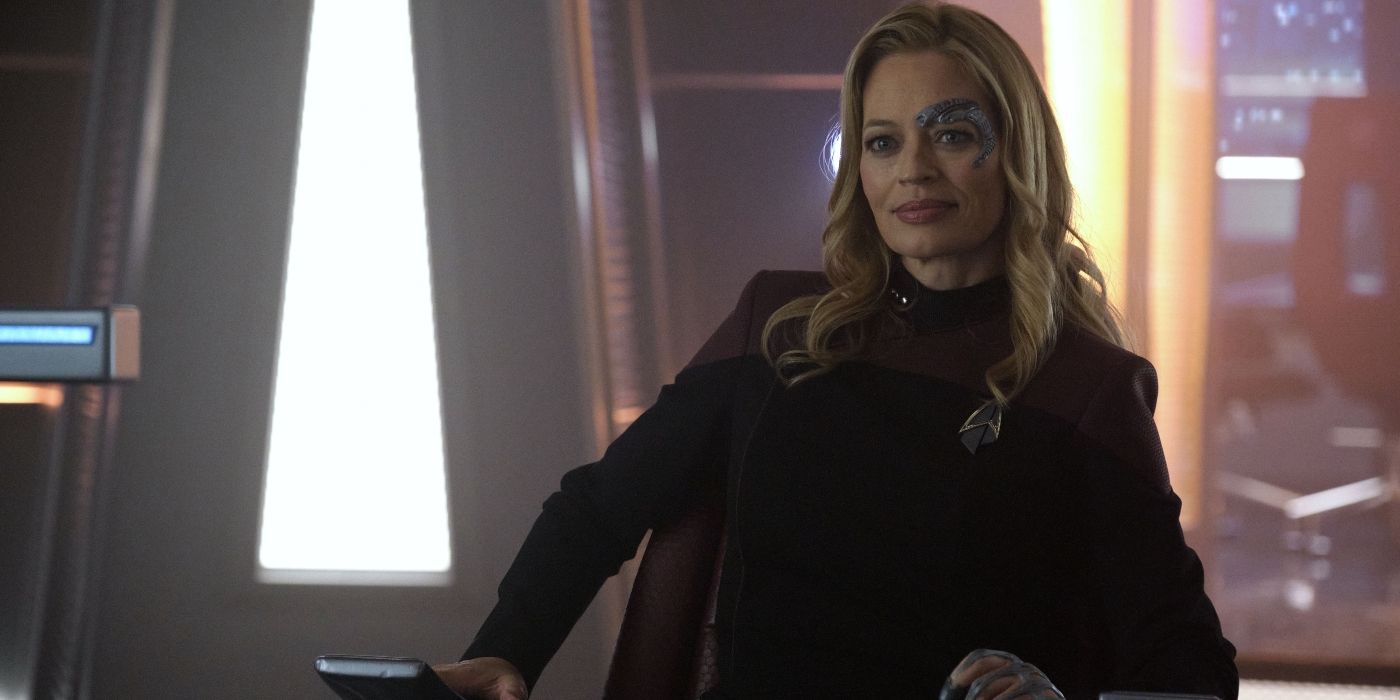Picard’ Season 3 Explains Deadnaming
Star Trek: Picard returned for its third and final season earlier this year and the long-awaited Next Generation reunion is delivering on a number of fronts, including the revelation that Jean-Luc Picard (Patrick Stewart) and Beverly Crusher (Gates McFadden) share a son. Along with that revelation, we’ve learned that the Changelings are back and they’re out for blood, Worf now works for Section 31, and Riker and Troi are having marital problems. We’ve also seen a whole host of new characters introduced through Seven of Nine’s (Jeri Ryan) position as first officer of the USS Titan—the ship that Riker (Jonathan Frakes) and Picard commandeered in their mission to rescue Crusher. On the Titan, we’ve been introduced to new allies as well as new enemies, and some people who fall somewhere in the middle.
In the first episode of Picard Season 3, we meet Captain Liam Shaw (Todd Stashwick), a no-nonsense, by-the-book boss with a chip on his shoulder for the Borg. This is also where we meet Ensign “Crash” La Forge aka Sidney La Forge (Ashlei Sharpe Chestnut), the eldest daughter of Geordi La Forge (LeVar Burton), an eager-to-please helmsman who’ll do anything to protect her crew. On top of being wonderful additions to the series, these two characters have also helped to explain an all-too-common queer experience in a way that any viewer can understand.
What Is Deadnaming?
Deadnaming is what happens when transphobic individuals refer to trans and non-binary queer people who’ve chosen new names for themselves by their birth name. Chosen names are common among queer people who don’t align with the name and gender that they were assigned at birth. In the context of Star Trek, Seven of Nine was named Annika Hansen as a baby but now chooses to go by Seven. Aboard the Titan, Shaw insists that the crew call her Commander Hansen, however, Sidney calls her Commander Seven as a sign of respect. While her chosen name is linked to her Borg designation, every time Shaw, or any other character refers to Seven as Annika Hansen they are intentionally dehumanizing her by denying her true identity. When you call a trans or non-binary person by their dead name, you’re denying who they are and disrespecting the very core of who they are.
Star Trek’s Complicated History With Queer Representation
Seven of Nine is far from the first queer person in Star Trek, but the franchise has had a long and complicated history with queer representation. Having been created in the 1960s, when having queer characters on screen was practically unheard of, Star Trek has long been a frontrunner in pushing for better representation on television, but the journey to the franchise’s first openly queer characters and relationships is a long one — and one that’s far from over.
While The Original Series does hold the groundbreaking first kiss between an interracial pairing, a kiss between two characters of the same sex wouldn’t happen in Star Trek until 1995 on Deep Space Nine. Prior to Star Trek‘s 2017 revival with Discovery, DS9 had certainly done the most in terms of pushing the envelope for making space for queer people in this sci-fi future. In a 1992 episode of The Next Generation, Picard and the crew of the Enterprise encountered a planet with a completely non-binary society. While it’s not a perfect allegory, the episode was intended to shine a light on the issue of conversion therapy that was particularly prevalent at the time.
When the Trill were introduced in The Next Generation, the show briefly addressed the idea of falling in love with a person no matter what body they happen to be in. Deep Space Nine took the concept further with Jadzia Dax (Terry Farrell), a Trill in a female body whose previous host body had been male. Jadzia rekindled a romance with her former host’s lover in the episode “Re-Joined,” leading to the show’s first (and for over 20 years, only) kiss between two women. Though Jadzia, and several other characters, were easily identifiable to the queer community as queer, Star Trek wouldn’t introduce its first openly queer characters until Star Trek: Discovery hit CBS All Access over two decades later.
The introduction of Stamets (Anthony Rapp) and Culber (Wilson Cruz), a queer couple played by queer actors, was groundbreaking for Star Trek fans, and they only arrived six years ago. The series also introduced the franchise’s first openly lesbian character in Tig Notaro‘s Jett Reno. The franchise’s adult animated series, Star Trek: Lower Decks, perhaps has the most freedom with their LGBTQIA+ characters with multiple characters falling under the queer umbrella and the show’s main character Beckett Mariner (Tawny Newsome) being openly bisexual and having a relationship with another woman in Season 3.
Seven of Nine’s queer journey wasn’t introduced until the Season 1 finale of Picard, though fans had speculated about her sexuality since she made her debut in the later seasons of Star Trek: Voyager. Seven and Raffi (Michelle Hurd) are Star Trek‘s first openly sapphic couple consisting of two major characters, and still, they’ve only shared one kiss — which is still only the second between two women in the live-action shows.
Even with Star Trek‘s rocky road to better queer representation, queer people have always been a part of the franchise. Original Series star George Takei came out as gay over 40 years after playing Hikaru Sulu in 2005. Now, various actors across all of Star Trek‘s currently airing shows identify as part of the LGBTQIA+ community. The concept of a romantic relationship between Kirk (William Shatner) and Spock (Leonard Nimoy) is one of the driving forces behind the series’ longevity, as it’s still one of the most popular ships in the world of fandom with the first Kirk/Spock fan fiction dating back to 1974.
Using the Borg as an Allegory for the Queer Experience
While it’s the most explicit, explaining deadnaming through Seven is not the first time that Star Trek has used the Borg as a queer allegory, intentionally or not. When the Borg were introduced on The Next Generation, the episode “I, Borg” centered around the concept of breaking away from the collective to find your own individuality and identity—another common experience for queer people, especially those raised in particularly heteronormative environments. When Picard and the crew of the Enterprise found a Borg drone in critical condition, they bring him to the ship and discover that people can reclaim, or begin anew, their own identities outside of the collective.
In Season 1 of Picard, Hugh returned as the leader of the xB movement and the Executive Director of the Borg Reclamation Project. While Hugh’s sexuality is never stated, the character is played by Jonathan Del Arco who identifies as a gay man. Following his return in Season 1, Del Arco spoke about how he imbued this character with his own experiences as a queer person saying, “to be able to play Hugh again with all the things I carry as a gay man and that I can put into my work is a great pleasure.”
Using the Borg as a framework for explaining deadnaming introduces the concept in a way that non-queer people can also understand. While many people outside the queer community do understand that it’s simply respectful to call someone what they ask to be called, bigoted people will use any excuse to call someone by their dead name. By using Shaw’s fear of the Borg as a reason to call Seven by her dead name, it gives people a new context in which to understand why it’s so disrespectful. Despite having genuine trauma around the Borg, Shaw’s treatment of Seven, and Picard to an extent, is still out of bounds as Seven and Picard cannot change the past or who they are because of it. Seven has more than proven herself over the last 30 years, earning her place among the stars, and along the way, she’s struggled plenty with her own identity. Coming to a place where she can accept herself as she is is a huge deal, and it’s only logical that she long to seek out a community that also accepts her.
It’s also extremely satisfying to see Seven’s chosen name used as an indicator of who can be trusted. In Picard Season 3 Episode 3, “Seventeen Seconds,” Ensign La Forge reaches out to Seven after she’s been confined to quarters for insubordination to offer a word of support and community. Later in Episode 4, when a changeling imposter arrives pretending to be Sidney, Seven is able to identify the threat because this version of the ensign uses her dead name, an order given to the crew by Captain Shaw. When the changeling calls her Commander Hansen, Seven takes her out knowing this person is there to sabotage their mission because Ensign La Forge always calls her “Commander Seven, out of respect.” Here, Shaw begins to realize that he’s underestimated Seven and that the way he’s been treating her is unacceptable.
‘Star Trek’ Needs to Keep Showing Up for Queer People and Minorities
While Star Trek has come a long way in its representation of queer people, especially in the last five years, the series needs to keep showing up for us. These characters live in the future, anywhere from 200 to 400 years from now — we deserve to see ourselves among the stars as much as anyone else. Franchise creator Gene Roddenberry‘s vision for Star Trek is rooted in the very simple concept of “Infinite Diversity, in Infinite Combinations.” The world is vast and filled with people who have all kinds of identities and cultures, and if Star Trek truly wants to boldly go where no one has gone before then the franchise needs to keep pushing the boundaries of what’s been done on television. We need a Star Trek where everyone can see themselves among the stars.
New episodes of Star Trek: Picard arrive on Paramount+ every Thursday.




